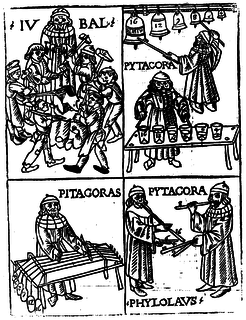 W
WThe Druze are an Arabic-speaking esoteric ethnoreligious group originating in Western Asia who self-identify as The People of Monotheism (Al-Muwaḥḥidūn). Jethro of Midian is considered an ancestor of the Druze, who revere him as their spiritual founder and chief prophet. It is a monotheistic and Abrahamic religion based on the teachings of Hamza ibn Ali ibn Ahmad and the sixth Fatimid caliph, al-Hakim bi-Amr Allah, and Ancient Greek philosophers such as Plato, Aristotle, Pythagoras, and Zeno of Citium.
 W
WThe Golden Verses are a collection of moral exhortations comprising 71 lines written in dactylic hexameter. They are traditionally attributed to Pythagoras.
 W
WHarmonices Mundi is a book by Johannes Kepler. In the work, written entirely in Latin, Kepler discusses harmony and congruence in geometrical forms and physical phenomena. The final section of the work relates his discovery of the so-called "third law of planetary motion".
 W
WMonad refers, in cosmogony, to the Supreme Being, divinity or the totality of all things. The concept was reportedly conceived by the Pythagoreans and may refer variously to a single source acting alone, or to an indivisible origin, or to both. The concept was later adopted by other philosophers, such as Gottfried Wilhelm Leibniz, who referred to the monad as an elementary particle. It had a geometric counterpart, which was debated and discussed contemporaneously by the same groups of people.
 W
WA monochord, also known as sonometer, is an ancient musical and scientific laboratory instrument, involving one (mono-) string (chord). The term monochord is sometimes used as the class-name for any musical stringed instrument having only one string and a stick shaped body, also known as musical bows. According to the Hornbostel–Sachs system, string bows are bar zithers (311.1) while monochords are traditionally board zithers (314). The "harmonical canon", or monochord is, at its least, "merely a string having a board under it of exactly the same length, upon which may be delineated the points at which the string must be stopped to give certain notes," allowing comparison.
 W
WThe musica universalis, also called music of the spheres or harmony of the spheres, is an ancient philosophical concept that regards proportions in the movements of celestial bodies – the Sun, Moon, and planets – as a form of music. This "music" is not thought to be audible, but rather a harmonic, mathematical or religious concept. The idea continued to appeal to scholars until the end of the Renaissance, influencing many kinds of scholars, including humanists. Further scientific exploration discovered orbital resonance in specific proportions in some orbital motion.
 W
WMysterium Cosmographicum is an astronomy book by the German astronomer Johannes Kepler, published at Tübingen in 1597 and in a second edition in 1621. Kepler proposed that the distance relationships between the six planets known at that time could be understood in terms of the five Platonic solids, enclosed within a sphere that represented the orbit of Saturn.
 W
WAccording to legend, Pythagoras discovered the foundations of musical tuning by listening to the sounds of four blacksmith's hammers, which produced consonance and dissonance when they were struck simultaneously. According to Nicomachus in his 2nd century CE Enchiridion harmonices Pythagoras noticed that hammer A produced consonance with hammer B when they were struck together, and hammer C produced consonance with hammer A, but hammers B and C produced dissonance with each other. Hammer D produced such perfect consonance with hammer A that they seemed to be "singing" the same note. Pythagoras rushed into the blacksmith shop to discover why, and found that the explanation was in the weight ratios. The hammers weighed 12, 9, 8, and 6 pounds respectively. Hammers A and D were in a ratio of 2:1, which is the ratio of the octave. Hammers B and C weighed 9 and 8 pounds. Their ratios with hammer A were and. The space between B and C is a ratio of 9:8, which is equal to the musical whole tone, or whole step interval.
 W
WPythagorean tuning is a system of musical tuning in which the frequency ratios of all intervals are based on the ratio 3:2. This ratio, also known as the "pure" perfect fifth, is chosen because it is one of the most consonant and easiest to tune by ear and because of importance attributed to the integer 3. As Novalis put it, "The musical proportions seem to me to be particularly correct natural proportions." Alternatively, it can be described as the tuning of the syntonic temperament in which the generator is the ratio 3:2, which is ≈702 cents wide.
 W
WAccording to some twentieth-century philosophers, unit-point atomism was the philosophy of the Pythagoreans, a conscious repudiation of Parmenides and the Eleatics. It stated that atoms were infinitesimally small ("point") yet possessed corporeality. It was a predecessor of Democritean atomism. Most recent students of presocratic philosophy, such as Kurt von Fritz, Walter Burkert, Gregory Vlastos, Jonathan Barnes, and Daniel W. Graham have rejected that any form of atomism can be applied to the early Pythagoreans.